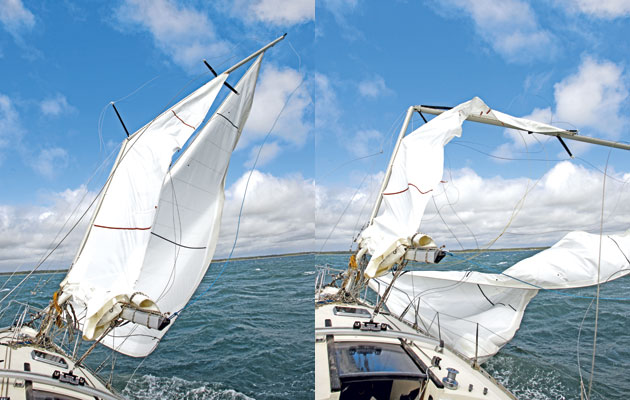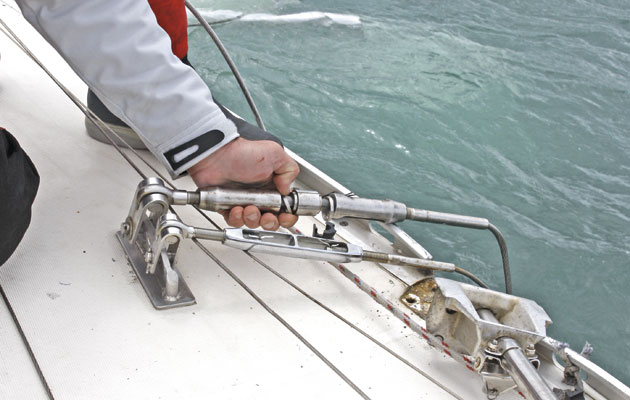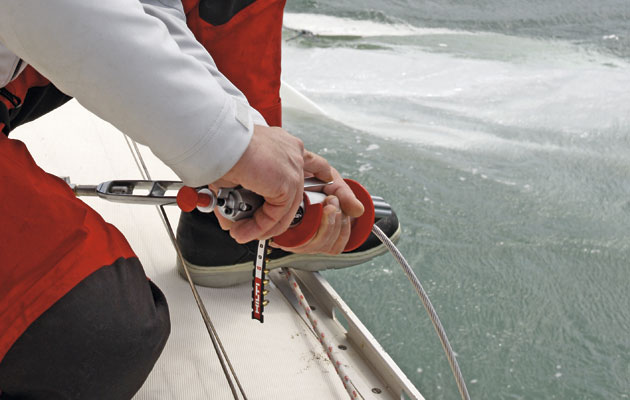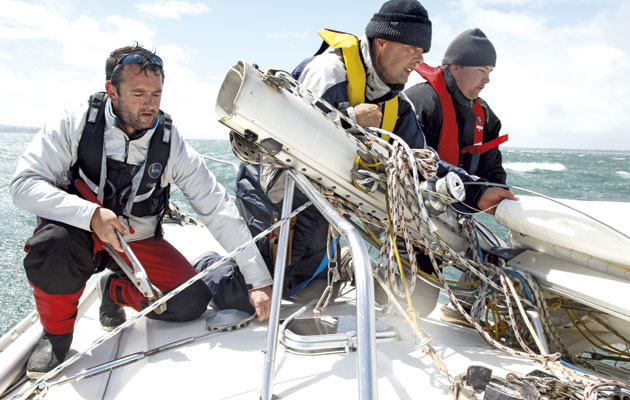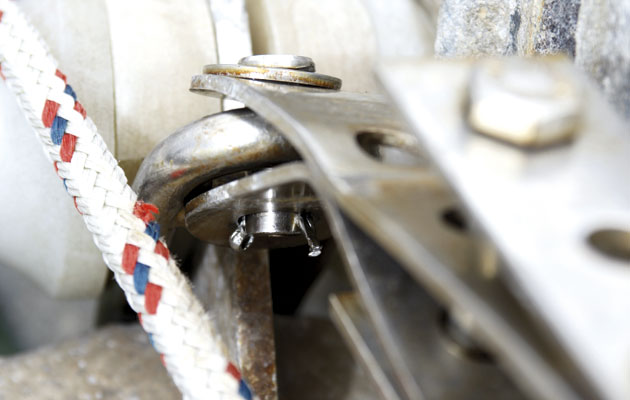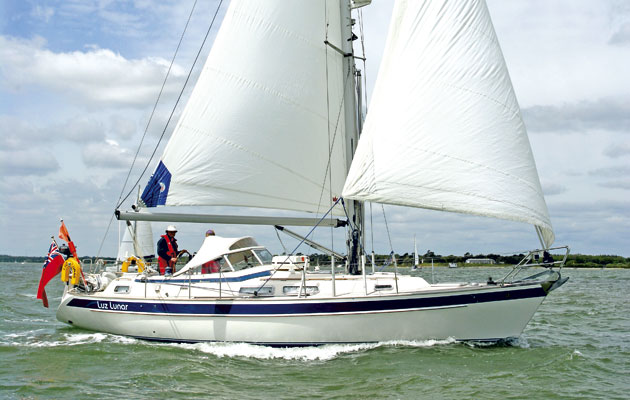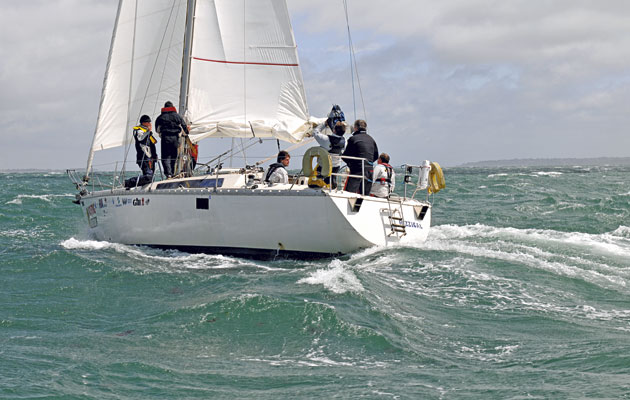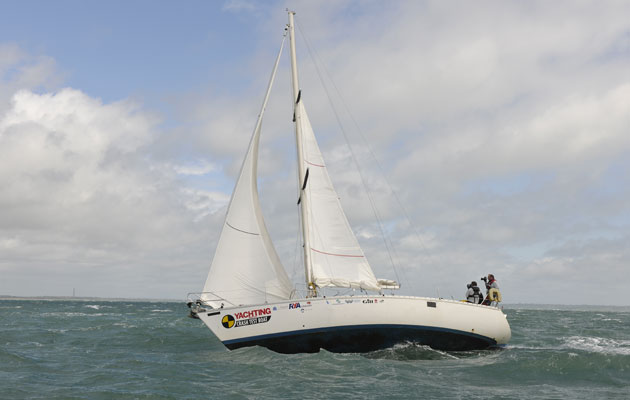What do you do when your sailing world crashes round your ears? Chris Beeson and the Crash Test crew created a ‘controlled’ dismasting in a gale and put eight rig-cutting tools to the test
Crash Test Boat – Dismasting
The mast: elegant, upstanding, unwavering – the very definition of seamanship under sail since the Egyptians first pioneered wind-powered trading vessels over 5,000 years ago. Without a mast, we are merely motorboaters. If it’s free of structural defects, well maintained and you reef appropriately in strong winds, it will give years of sailing pleasure.
But what happens if it does break? The best case scenario is an abrupt end to your day’s sailing. You clear all lines from over the side and motor home with a slightly shaken but otherwise uninjured crew, and an expensive story to tell. The worst outcome is that the mast injures the crew, then its wreckage punctures the hull and your boat sinks.
To minimise the chances of a drama turning into a total disaster, it’s vital to clear the wreckage and cut away the rigging quickly. But how effective are the £30 set of bolt croppers you bought from a DIY store several years ago? They’ll probably have been buried in a locker and be rusted solid by the corrosive marine environment. Can you use them on a wet, rolling deck when you need one hand for the ship? Will the jaws’ scissor action cut through effectively?

The dismasting was controlled but the damage was real enough and the adrenalin was flowing through us all
These are some of the questions we wanted to answer. We researched every method of cutting shrouds so we could evaluate them in a real-life situation at sea. We ruled out a 12v angle grinder, which some recommend, because using electrical equipment on a wet, rolling deck is extremely hazardous. The tools we decided to test were:
- Pliers
- Nail pinchers
- Hacksaw
- Bolt croppers
- Cable cutters
- RigOff, a dismantlable bottlescrew
- Hydraulic cutters
- Shootit, which uses a small explosive charge
What happens after a mast breaks?
Paul Lees, from Crusader Sails, a veteran of three dismastings, forewarned the crew that a dismasting is actually fairly sedate process, because the sails slow down the action of gravity. Having experienced it for the first time, I’m not sure sedate is the word, but it certainly wasn’t as violent as I had expected.
From my position at the genoa sheet winch, it looked at first as if the genoa halyard had parted but a split second later the mast collapsed with a crack that was just audible over the noise of the wind. The backstays settled across the cockpit, rather than scything down like a cheesewire, as I had feared. Paul advised us that when the rig goes, the safest places to be are down below, aft of the twin backstays or lying in the cockpit. We did as we were told and nobody was hurt.
The most notable difference was the increased rolling. Without the mast and sails to dampen the motion, the yacht rolled faster and more frequently. Moving safely on deck was a hands and knees affair, except for the youngest and nimblest crewman, Mark. With the yacht’s severe motion and a lack of lifelines, we all wore lifejackets – there was a very real risk of somebody falling overboard.
We didn’t clip on with tethers, though, for several reasons. We wanted freedom of movement in case several hundred kilogrammes of twisted aluminium suddenly decided to shift. Secondly, on a deck festooned with lines and shrouds, we would have been clipping and unclipping every couple of feet.
Add to that the chances of accidentally clipping onto the lifelines, only to be dragged overboard as the mast slid over the side. It would be easy to get tangled in the wreckage and cordage and be dragged under.
Recovering the wreckage

After securing the stump, the first job was to get the boom and mainsail below, clearing space on deck and leaving us enough kit for a jury rig. The main halyard was cut at the stump, the sail hauled down its track, the gooseneck unbolted and the lot moved below
The plan, which couldn’t be completely formed until we knew what wreckage we were dealing with, was to secure the stump, then remove the boom’s gooseneck, kicker and mainsheet and stow it below, along with the mainsail, for potential jury rigging. This would also clear deck space. Next, the outboard end of the stump would be hauled alongside and inboard by securing lines around it and winching it within reach. With the stump secured, we would try to haul the top section alongside and repeat the process. This second stage promised to be far more difficult because of the weight of water in the genoa.
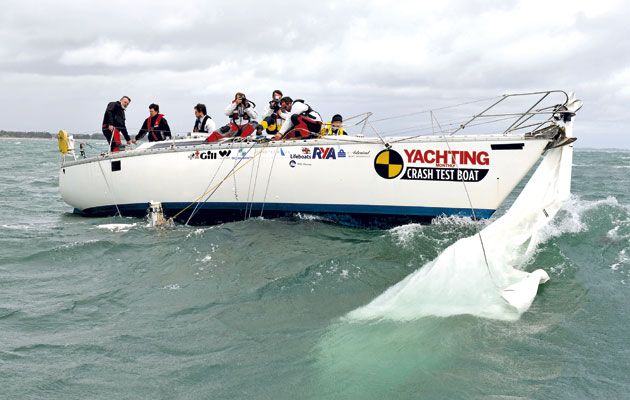
While cutting away the rigging, the stump escaped the lashings securing it and slipped over the side. Rolling as we were, it could easily have punched through the hull. We managed to haul it back aboard, but it took four of us nearly three hours
In the half-hour I spent testing the shroud cutting tools, the boom and mainsail were stowed below. The mainsail was freed by cutting the halyard – but the mast stump had slipped over the side. We spent two hours hauling it back aboard, by which stage we had drifted five miles east, on wind and tide, to beyond West Lepe. We were too close to shipping lanes to continue our test, so we secured one end of a mooring line to the top section, tied a fender to the other and cut the forestay to ditch it (our support boat, Dave Kennett’s Dunlin, recovered it). After checking for lines over the side, we started the engine and motored home.
The lesson we learned about recovering a wrecked mast is that, on boats over 30-35ft, it’s just not possible for an average coastal cruising couple. Saving the boom and mainsail was fairly easy and left us something to jury-rig, but even getting the stump aboard was extremely hard work for four relatively fit and strong crew. The solution is to buoy the wreckage if you’re in shallow water, to enable recovery, then cut it free. If you’re in open ocean you’ll have rather longer to recover the rig, but the sea state will make recovery even harder and the potential for holing far greater.
Dismasted at night
Even during daylight, moving around the deck, cutting the right halyards and distinguishing lifelines from rigging wasn’t as easy as you’d think. At night, I would have real concerns for the safety of anyone working on deck. A lifejacket, harness and lifeline are essential, as is a head torch. A decent multi-tool, in addition to your rigging cutters, is also recommended. Check the jackstays are secure before leaving the cockpit, as they may have been damaged during dismasting, and exercise extreme care on deck.
A hole in the hull
This is the big worry when the mast goes over. We took some heavy gelcoat gouges in the topsides but no punctures. That may be due to the fact that our Francespar had hinged spreaders, riveted to the mast, that folded up as soon as the shrouds parted. Welded spreaders, or those supported through the mast by a rod, are stronger and would have offered the mast more support but they would also remain in place and present a greater danger of holing, making the need to ditch the spar all the more urgent.
Cutting tools on test
After the mast fell to leeward, we took stock of the situation. The boat’s momentum carried her round to windward of the rig, but with wind and waves pushing the hull downwind faster than the tide, the sails became a sea anchor, with the main doused to starboard and genoa ballooning to port. Within minutes the yacht scraped back to leeward of the wreckage. Wind-rode, there she stayed, beam on to wind and waves, drifting east up the Solent’s mainland shore.
Then we began to free the hull from the wreckage, pulling out clevis pins with some tools and cutting shrouds with others. The Crash Test Boat had 8-10mm 1×19 stainless steel wire rigging. The deck was wet, covered with sails, rope and shrouds. Some of the starboard stanchions were torn out of the deck and the lifelines were down. Without her mast, the yacht was rolling like a fairground ride.
Nail pincers around £4
These came from photographer Lester McCarthy’s expansive and well-maintained toolkit. He had several pairs, but I chose the ones with jaws that opened wide enough to grip the head of the clevis pin. If they don’t, they’re useless for this task. In our test, these performed better than the pliers, possibly because of their condition. The advantage of being able to clamp the jaws over the head of the clevis pin makes them better suited to the task than pliers. They can be used one-handed, too, but share the same problem as the pliers: no use if there is any load in the stay, or the bottlescrew’s split pin is inaccessible.
Pliers around £7
Every boat has a set of pliers. They’re cheap to buy and easy to use one-handed. Ours were part of a budget Halfords toolkit. They were corroded after our capsize test but performed well in removing a split pin and drawing out the clevis pin on one of the twin backstays.
It took a minute to free the backstay from its chainplate but, crucially, there was no load in the stay. Had there been, I couldn’t have pulled out the clevis pin. It’s also possible that a bottlescrew could fall so that the split pin was facing the deck, making it inaccessible without manhandling the shroud.
Hacksaw with bi-metal blade around £23

It took 20 seconds to cut through the last, heavily loaded stay, and I still had a hand for the ship
It’s a false economy to buy a cheap hacksaw, as I discovered. My £8.99 hacksaw, from a DIY store, had a plastic blade-retaining pin that soon snapped, so we used photographer Graham Snook’s sturdy metal hacksaw with a stainless steel cutting blade – standard blades will blunt quickly sawing through rigging.
The leeward D2 shroud was heavily loaded and hanging over the rail. With the lifelines torn out and the boat rolling heavily, a two-handed tool would have presented real problems. I held the hacksaw with one hand and the mangled granny bars with the other. Though tricky to cut accurately, with boat and rigging moving independently, it took just 20 seconds to cut the shroud, strand by pinging strand.
Bolt croppers around £80
Again, we plundered Lester’s tool kit and found two pairs of bolt croppers, one that opened just wide enough to enclose the rigging and another that could potentially have cut the mast in two. I chose the former. Made in Germany, the price and origin remain a mystery.
I had expected the rigging wire to squeeze out of the jaws, requiring several chomps and damaging the blades, but they cut through at the first attempt. Using the proven technique of the full range of the handles and the built-in cam action, I needed less grunt than I expected. These were heavy, two-handed tools, so you need to brace yourself well. Good-quality bolt croppers are expensive.
RigOff £116.20 each
Made by UK inventor Cameron Jemison, this is a bottlescrew that dismantles. A pair of two-piece rubber collars peel apart, two retaining flanges slide out and the centre section falls into three pieces. Production is small-scale, with Cameron looking for a licensee. If the product is successful, prices will come down.
The RigOff was fitted to the heavily loaded leeward cap shroud. Despite lack of access to the underside, removing the rubber collars was easy enough but the flanges didn’t fall away and weren’t going to be moved by hand. After a kick, the top flange fell away, followed by the second as the unit fell apart, as designed. It’s one-handed, involves minimal effort and no tools but, under load, the flanges needed some persuasion.
Cable cutters around £160
These came from and Paul Lees’s toolkit. Their primary advantage is that an indent in one blade holds the shroud captive. These are Swiss-made Felco cutters – a very decent pair, strong enough to cut six stays without damaging the blades – so they are expensive.
Despite their size, bigger than the bolt croppers, the steel-cored aluminium handles made them much lighter, but they still required two hands. Without the mechanical advantage of the bolt croppers’ cam action, they required far greater effort. With the stay held captive, I eventually placed one handle on the deck and leant all my weight on the other. They cut cleanly but there was no chance of using one hand for the ship.
Shootit around £499
Designed to cut through stays, this German-made device uses the same sort of explosive charge used in nail guns. It worked perfectly and involved much less drama than I’d imagined. Press the red button to open the chamber, slide in the charge strip, close it, cock it, hook the jaw around the stay, remove the safety, press the silver trigger and the shroud was severed with absolutely no effort involved. It has no other uses, however, which affects its value for money score, and you can’t board a plane with the charges.
Hydraulic cutters £1,116.53 (wire up to 14mm)
We borrowed these from Holmatro dealer The Rig Shop in Southampton. They arrived in their own dry bag and suffered no ill effects from their immersion during the capsize test. Due to the pressures involved, hydraulic equipment is generally heavily engineered and that’s reflected in the price.
They couldn’t have been simpler to use: open the jaw and close it around the stay, then pump about 10 times. You can rest the handle on deck and operate it one-handed. They’re simple, effective and involve minimal effort, but they’re expensive and exclusively for cutting rigging.
(All prices correct in 2011)
What we learned
Cutting stays
The results were a surprise to me but, as I’m unaware of any other dismasted yacht that has been able to test in anger every practical method of cutting shrouds, I’ll stand by these findings. Significantly, we proved that loaded and unloaded stays are very different beasts and that tools you can use one-handed have a major advantage, particularly when the lifelines have been
swept away.
If you can afford them, the hydraulic cutters and the Shootit were the simplest, quickest and easiest ways to cut wire stays. A decent hacksaw, with bi-metal stainless steel-cutting blades, is also effective, can be used one-handed and has other uses. Make sure you have spare blades that are protected against corrosion.
Much to my surprise, the bolt croppers worked very well – much quicker and easier than the cable cutters, despite their weight and two-handed operation. But are you prepared to spend over £70 for a decent set that you’re unlikely to use? Probably not. A cheap pair, even if they haven’t rusted solid, won’t be up to the job of cutting six or more stays. If you choose bolt croppers, don’t skimp, and make sure the jaws open wide enough to enclose the stay fully.
You will already have a pair of pliers or nail pinchers on board. For unloaded stays, they offer a simple, cost-effective, multi-purpose solution but they won’t help on loaded stays. Don’t even try. That amount of stainless steel whipping back at speed could cause injury.
The RigOff is a clever piece of engineering and a refreshing approach to the problem. Bearing in mind it was heavily loaded and the shroud was over the side, its slightly recalcitrant performance is still creditable. You need at least six for an average sloop rig, so it’s not cheap, but you’d save on the cost of six standard bottlescrews.

With the tide taking us closer to shipping lanes, we cut the forestay and our support vessel salvaged the remains
The forestay was the last to be cut, and the trickiest. With the furling gear surrounding the stay, removing the split and clevis pins was a good theoretical solution. However, during our dismasting, the toggle took such a battering, deforming as it fell across the anchor, that the split pin could not be removed. Even if it could, the forestay is almost certain to be loaded because of your genoa-cum-sea anchor, so you’re unlikely to be able to remove the clevis pin.
With the forestay bent over the pulpit, the wire was exposed in one place, between the drum and the luff foil section. The gap wasn’t wide enough to use the Shootit or the Holmatro cutters and it was moving around too much for hacksawing. Crusader Sails’ Mark Lees clamped the cable cutters around the exposed wire and, after a few seconds contorting himself into a position where he could generate the required leverage, the stay parted.
How to avoid dismasting
Check your rig
Provided it’s free of structural issues and barring a knockdown, a rig never just fails. There are always signs of imminent failure and they’re not difficult to spot. Catch them in time and you will save your spar.
Check and tape split pins
They may seem insignificant but, make no mistake, a handful of properly fitted split pins will save your mast. Without them, bottlescrews and clevis pins work loose and you’ll lose the lot. Use the biggest split pin that will fit the hole, pack any space with stainless steel washers, insert the pin, spread both its legs into an anchor shape and secure with tape or a blob of silicone.
Check mainsail track sliders, cars or bolt rope
Just as a snapped furler line will leave you with far too much sail up, losing a few mainsail track sliders or tearing out your main’s bolt rope can leave the sail bulging to leeward. In a matter of seconds the wind can strip out the others, leaving you with a spinnaker where your mainsail used to be. Check the fastenings to both mast and sail are secure, repair if you’re in any doubt.
Check shroud terminals
Securing mooring lines to shroud bases is never a good idea because the loading can deform rigging toggles and weaken bottlescrews, creating uneven loading and increasing the chances of failure through fatigue. If there isn’t a cleat handy, use genoa cars, winches or padeyes instead. For standing rigging, check the top of the swage and look for any broken strands. If you find some, replace that shroud and its opposite.
Check your furler and line
Check the furling line. Make sure the lead onto the drum is fair and that there are no chafe points. If it’s looking tired, replace it. Remember, if the furling line breaks in a blow, you’ll have far too much sail up for the conditions and the loads will be critical. Also, check the grub screws on the collar where the drum meets the luff tube. The forestay shakes tremendously during tacks and those grub screws can easily come loose. Secure them with PVC or Loctite.
Send a rigger up the mast

Vibration can cause shackles to come undone over time. Seizing them with wire or cable ties prevents it
There is no tension in the stays of an unstepped mast, and that means broken strands can creep back into the swage, giving the appearance that nothing’s wrong. Once a season, send a rigger aloft. He can check for broken strands at the top of shrouds, cracks in terminals, or in the mast around terminal fittings, and make sure your shackles are properly seized and your sheaves are in good order.
Manage your canvas
The old adage states: ‘If you’re thinking about it, it’s time to reef.’ Barrelling along with the rail under is all good schoolboy stuff but it’s neither comfortable nor especially quick and you are stressing the rig unnecessarily. You wouldn’t drive your car at 50mph in second gear and a boat is no different.
Trim sails properly
Leaving sails to flog – even that pesky bit at the top of the genoa’s leech – shortens the life of the sail and shakes the entire rig. Get you know your sail controls and learn as much as you can about sail trim without laying yourself open to accusations of racing. Your sails and your rig will last longer and you’ll enjoy sailing more – and cut a more experienced dash on the water.
How we did it
We needed at least 20 knots of wind for this test. We set out from Lymington with a forecast WSW Force 5-7, occasionally 8. Bramblemet was recording a steady 30 knots. Despite wind-with-tide, we thought it would be more than enough.
We had an entire neap flood tide and the whole of the western Solent to play with before we troubled any shipping. We made sure there was enough water to avoid digging the masthead into the seabed, ‘pole-vaulting’ the boat over the spar and risking damage below the waterline.
With three reefs in the mainsail and a third of the genoa unrolled, we were storming around at 9-10 knots. We planned to dismast her just above the first spreaders by replacing the clevis pins on the leeward cap shroud and D2 with short lengths of 10mm fibreglass batten, or ‘fuses’, while on starboard tack, then tack over, harden up and wait for the bang. Mark and Jerry went forward to insert the ‘fuses’, taped them up and came aft. The battens were far stronger than anyone thought – the rig didn’t budge. ‘Next time someone tells me they’ve broken a batten, I’m going to ask them how they did it,’ marvelled Paul.
Undeterred, we wore around, gybing heavily enough to pull a mainsheet block off the boom. We replaced the 10mm battens with 6mm, tacked onto port again and waited. And waited. Finally, Paul called for more headsail and Mark accidentally let it all out. With the genoa shaking violently, the loads were finally high enough for the battens to shear.
Unstayed, the top of the mast arched to leeward. With a full genoa on a sagging forestay in 30 knots of wind, and the lowers holding the first spreaders in place, the mast took on an S shape as the extra compression loading crushed it on its step. Three seconds later the masthead hit the water.

Unsurprisingly the weakest point of the mast is just below the first spreaders, at the coquille holes
The break was at the point where the coquille terminals for the fore and aft lowers were positioned. These require four apertures in the mast and, once the cap shroud and D2 had parted, that was the weakest point.
The coquilles for the lowers then sprang out, leaving the stump unsupported. It bounced off its step and fell overboard.
Other tests in the Crash Test Boat series






